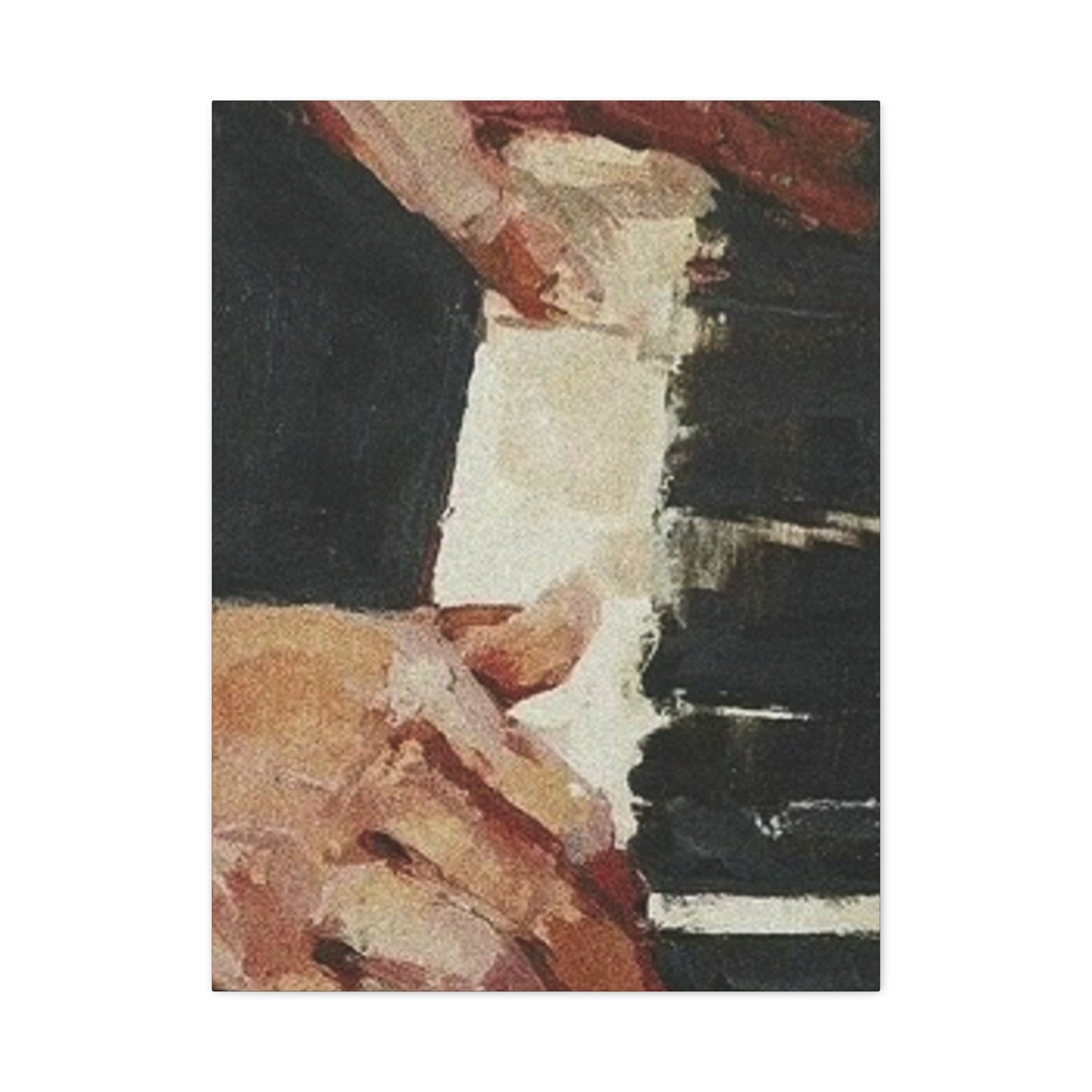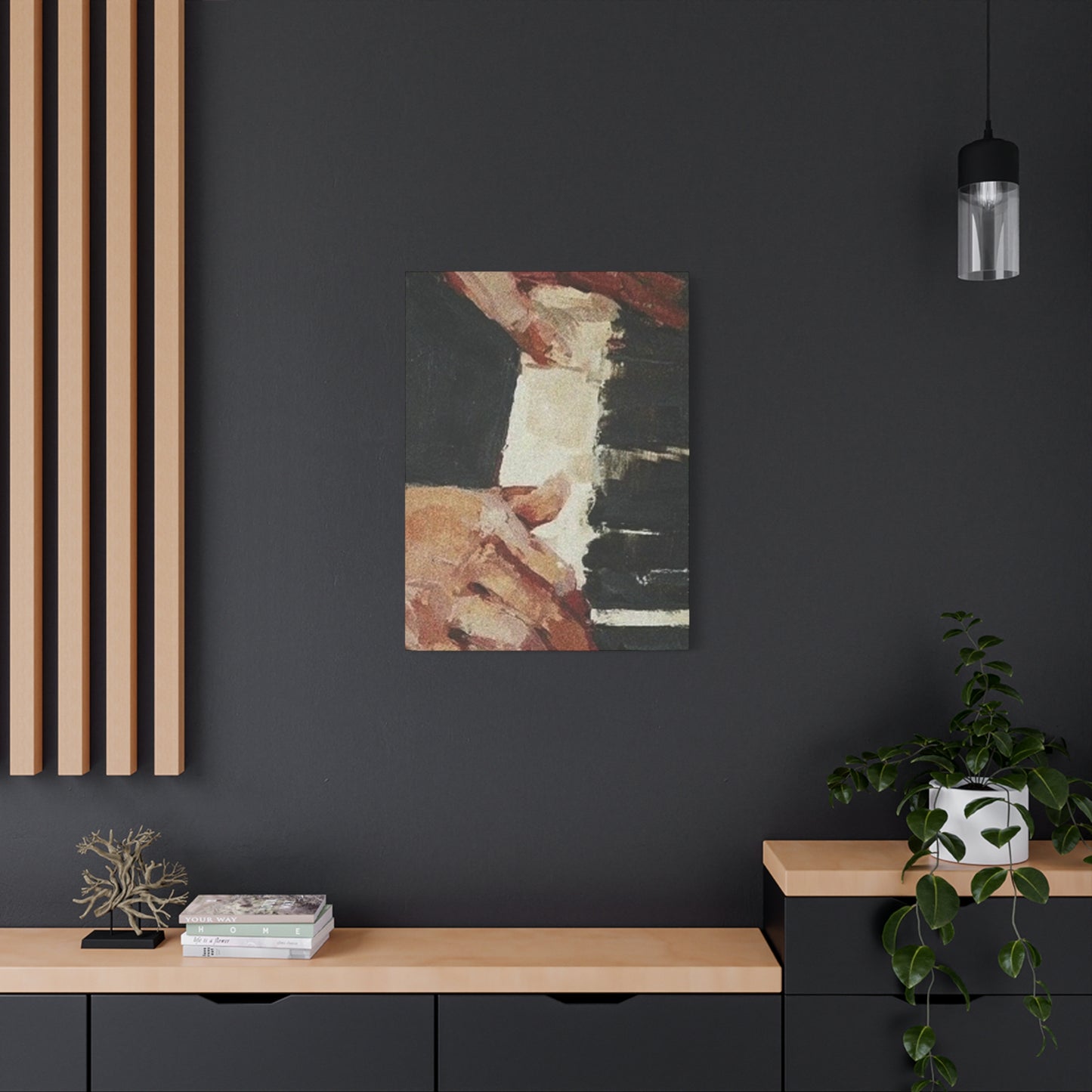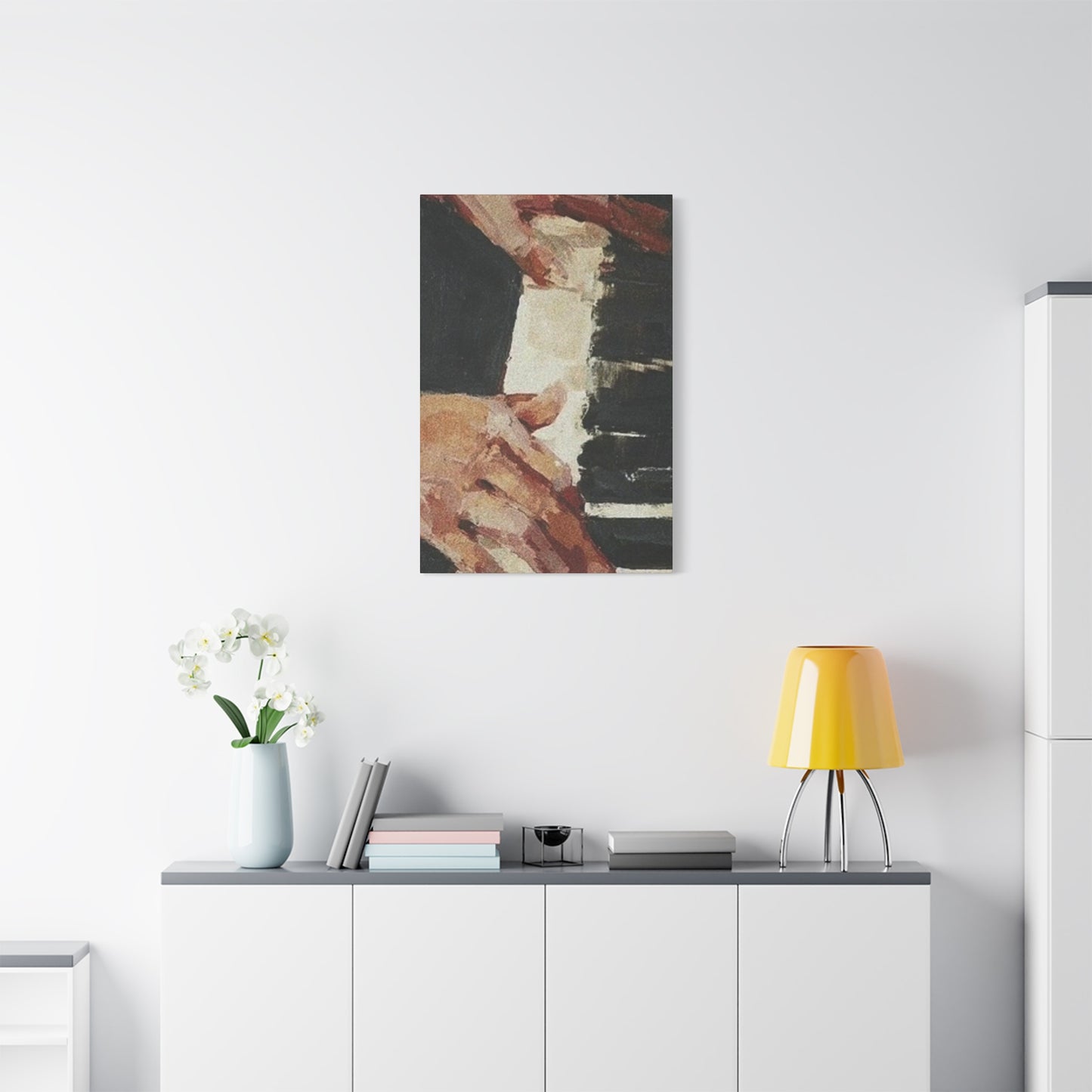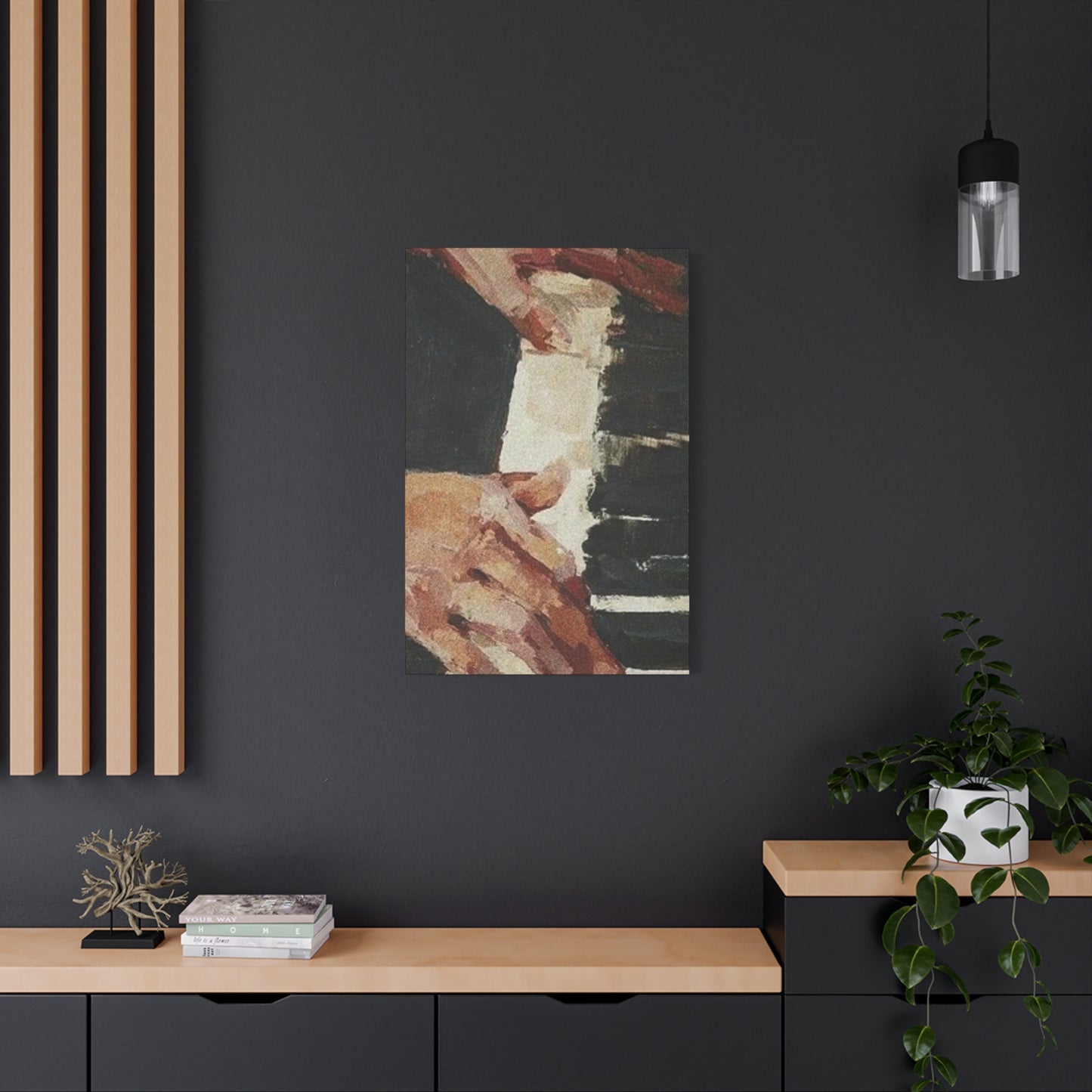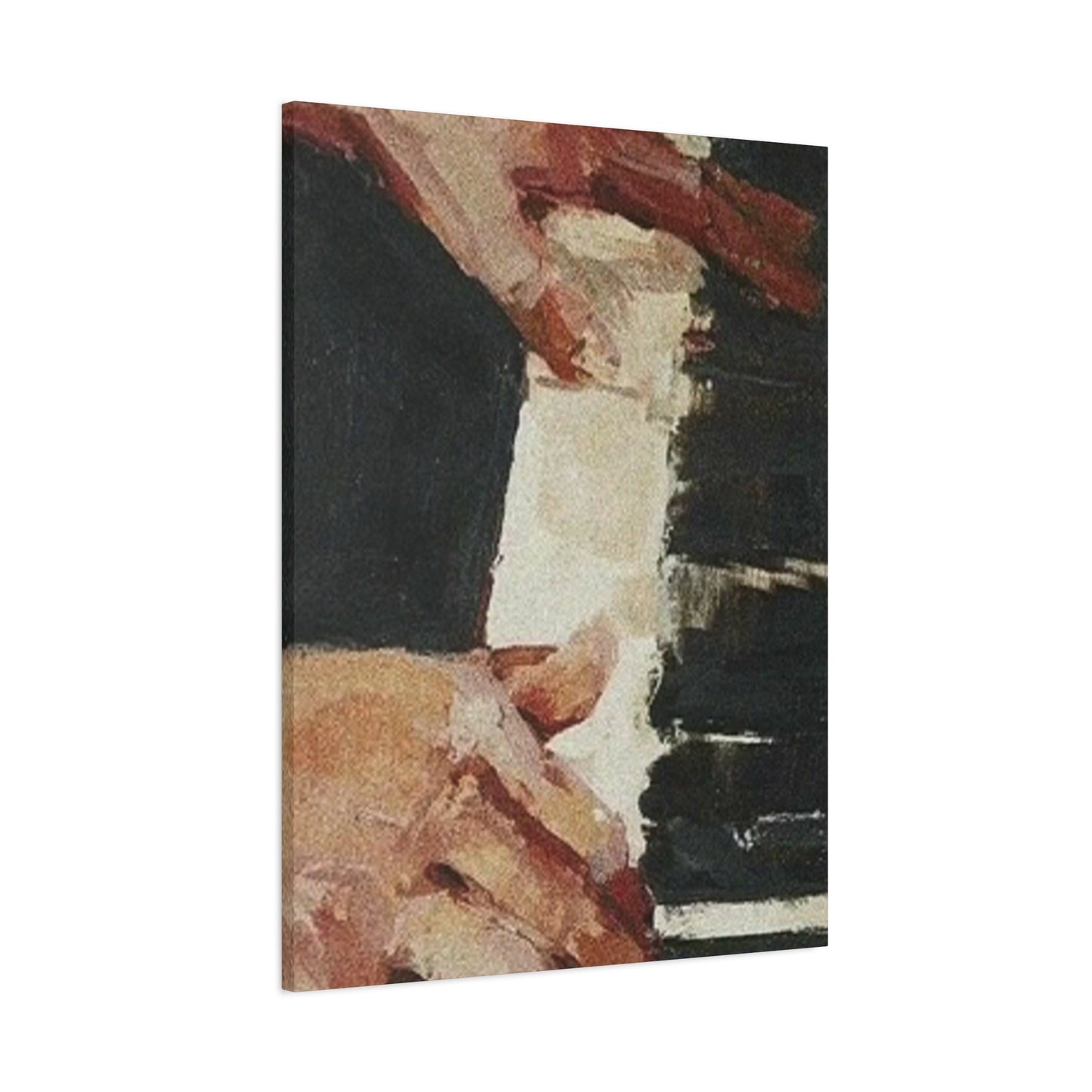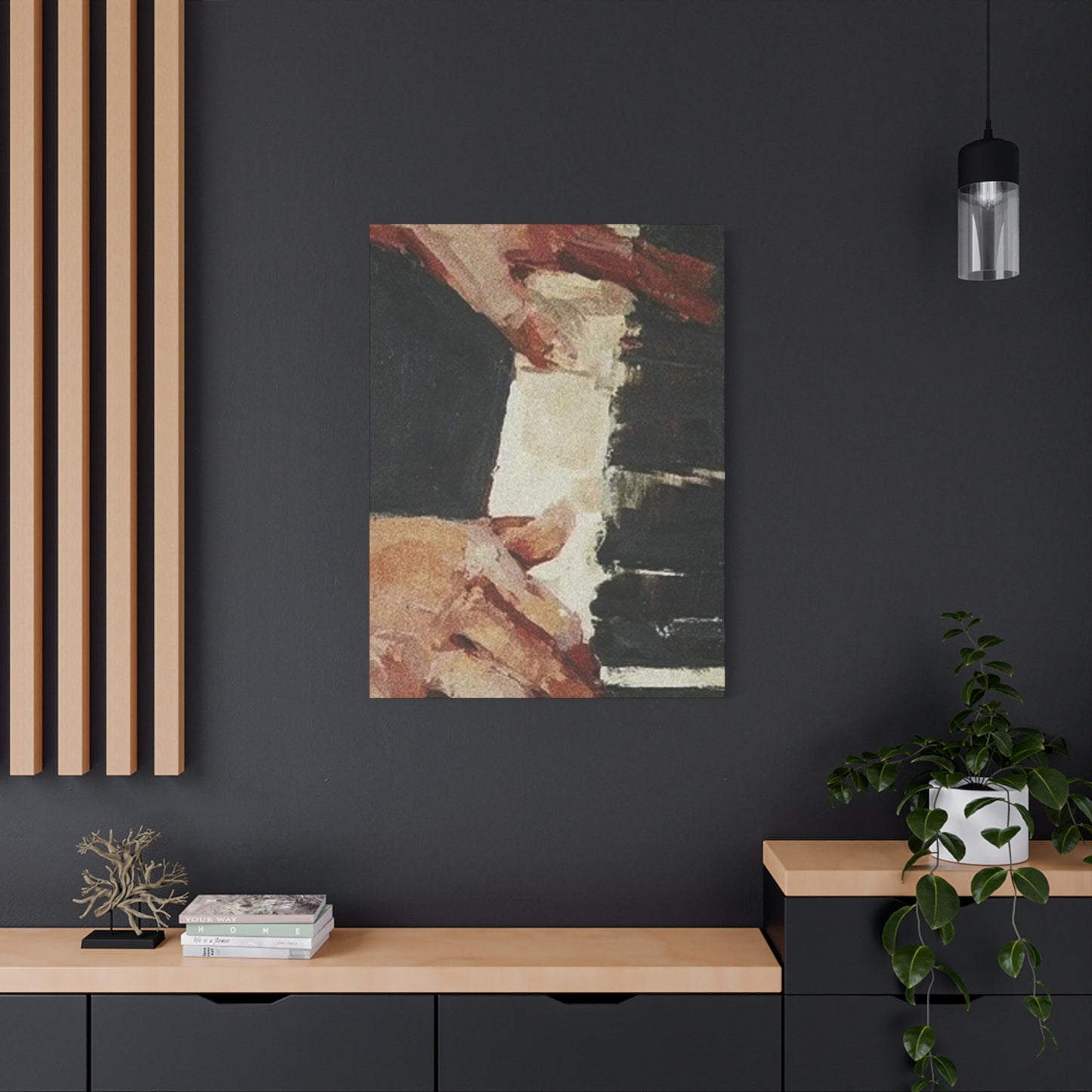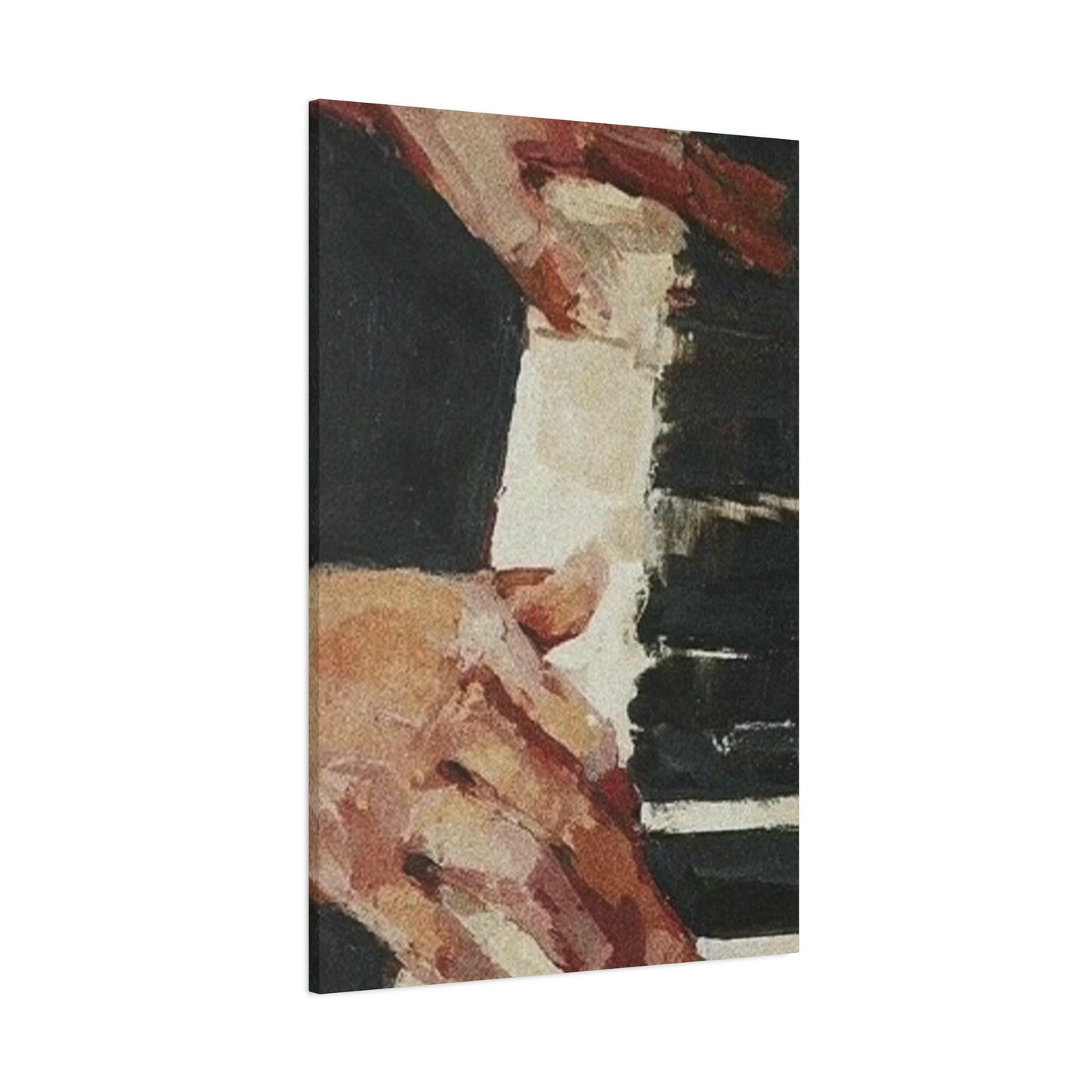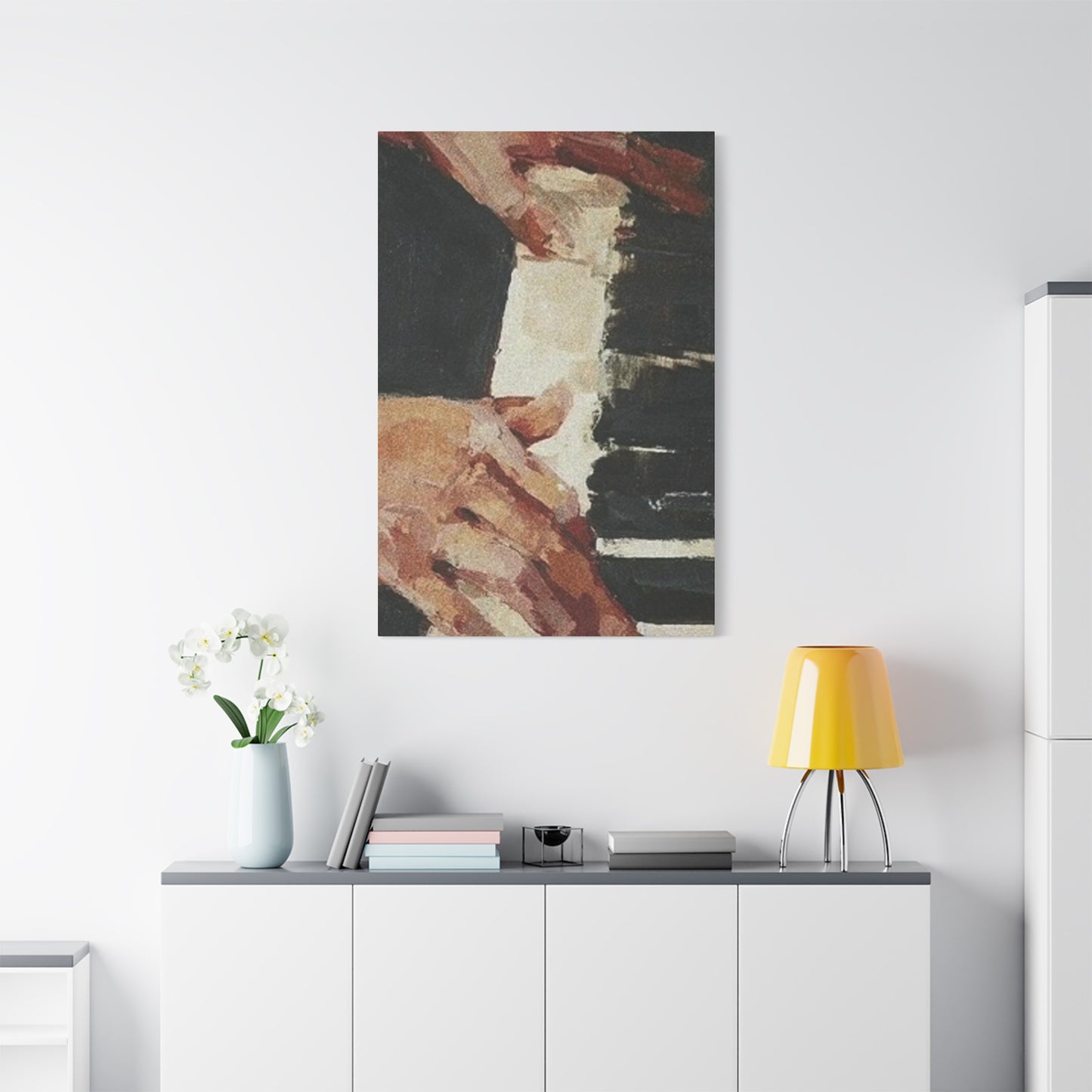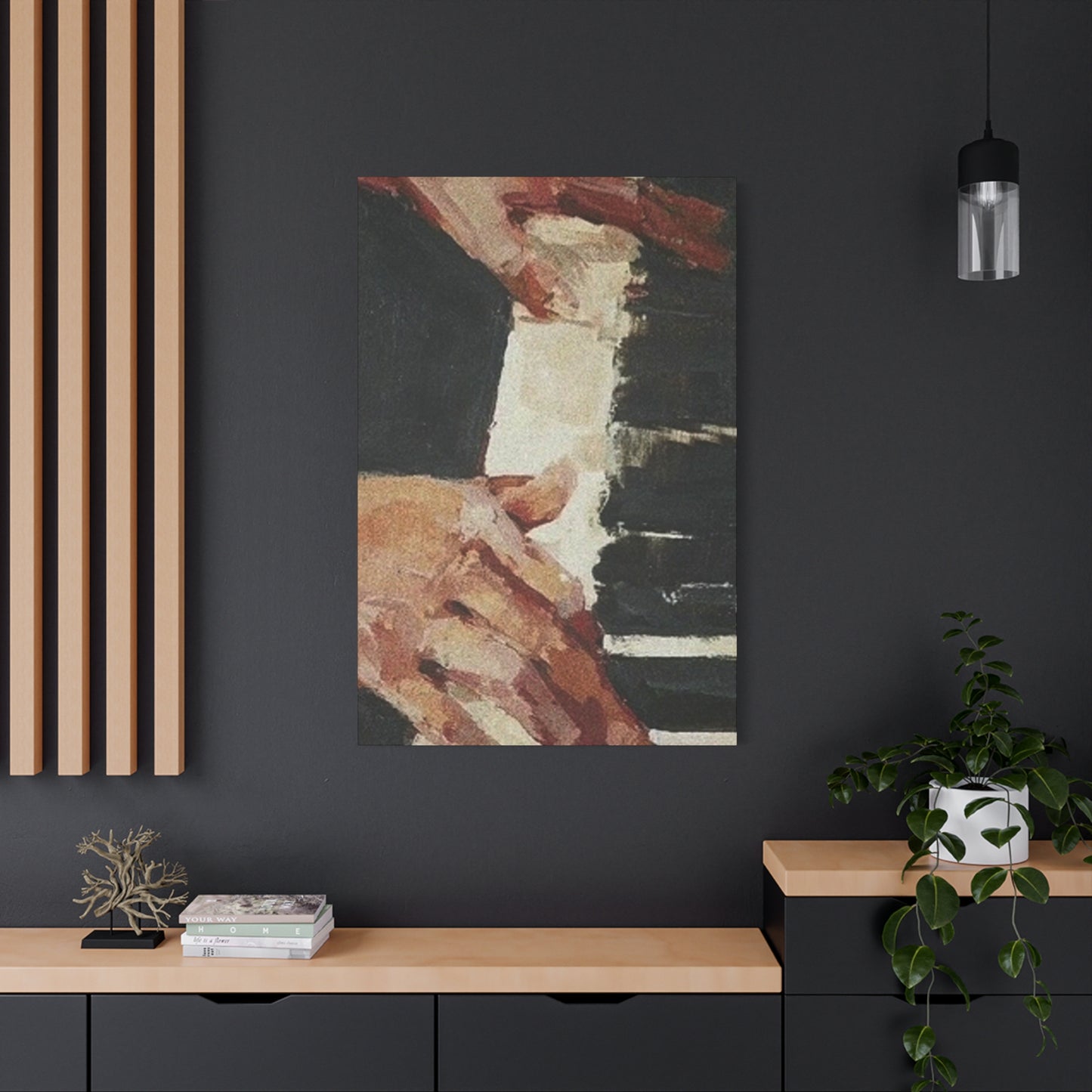Hands Playing Piano Wall Art & Canvas Prints
Hands Playing Piano Wall Art & Canvas Prints
Couldn't load pickup availability
Expressive Musical Décor: Elevating Your Living Spaces with Hands Playing Piano Wall Art
The allure of music transcends auditory experiences, manifesting itself through visual representations that capture the essence of melodic creation. Among the most captivating forms of artistic expression in home décor, hands playing piano wall art stands as a testament to the timeless beauty of musical performance frozen in a single, powerful moment. This form of decoration brings sophistication, emotion, and cultural depth to any interior space, transforming ordinary rooms into galleries of artistic appreciation.
The Magnetic Appeal Behind Keyboard-Focused Artistic Representations
The human fascination with musical instruments, particularly the piano, stems from centuries of cultural significance and emotional resonance. When artists capture the delicate dance of fingers across ivory and ebony keys, they preserve more than just a physical action—they immortalize the very soul of musical creation. These visual compositions speak to something fundamental in our collective consciousness, representing dedication, artistry, and the pursuit of excellence.
The piano itself carries profound symbolic weight across cultures and generations. It represents refinement, discipline, and creative expression. When depicted through visual mediums, especially focusing on the hands in motion, the artwork communicates stories of practice, passion, and performance. This symbolism makes such pieces particularly meaningful for music enthusiasts, performers, professional musicians, and anyone who appreciates the intersection of visual and auditory arts.
Hands playing piano wall art resonates deeply because it captures vulnerability and strength simultaneously. The human hand, with its intricate bone structure and remarkable dexterity, becomes an instrument itself when engaged with the piano. Artists who choose this subject matter understand that viewers connect not just with the instrument but with the human element—the dedication required to master such complex movements, the years of practice embedded in muscle memory, and the emotional expression channeled through fingertips.
Diverse Artistic Interpretations of Keyboard Performance Imagery
The market offers an astonishing variety of visual representations depicting pianists' hands in action. Photographic renditions capture the stark reality of performance, often showcasing close-up perspectives that reveal every detail—from the precise positioning of fingers on specific keys to the subtle shadows cast by stage lighting. These realistic portrayals appeal to purists who appreciate documentary-style authenticity and want their décor to reflect genuine musical moments.
Abstract interpretations take a dramatically different approach, distilling the essence of piano performance into colors, shapes, and gestural marks that suggest rather than explicitly depict. These pieces might use bold brushstrokes to imply motion, or employ color gradients to represent the flow of melody. Abstract hands playing piano wall art works particularly well in contemporary interiors where conceptual thinking and interpretive art are celebrated.
Impressionistic renditions strike a balance between realism and abstraction, capturing the mood and atmosphere of musical performance rather than photographic accuracy. These pieces often employ soft focus, muted color palettes, or painterly textures that evoke nostalgia and emotional depth. The impressionistic approach creates a dreamlike quality that can transform a space into a more contemplative, introspective environment.
Black and white compositions offer timeless elegance, stripping away color distractions to focus on form, contrast, and composition. Monochromatic hands playing piano wall art emphasizes the architectural beauty of both the instrument and the human form, creating dramatic visual impact through the interplay of light and shadow. These pieces possess a classic sophistication that transcends passing design trends, ensuring long-term aesthetic relevance.
Vintage-style artwork incorporating aged textures, sepia tones, or antique framing techniques appeals to those drawn to nostalgia and historical aesthetics. These pieces might reference specific eras of musical history, from jazz-age speakeasies to classical concert halls, adding layers of cultural context to the visual presentation. The weathered appearance of vintage pieces can add character and depth to spaces seeking an established, cultivated atmosphere.
Selecting the Perfect Musical Artwork for Your Environment
Choosing appropriate hands playing piano wall art requires thoughtful consideration of multiple factors, beginning with spatial dimensions and proportional relationships. Large-scale pieces make bold statements in expansive rooms with high ceilings, serving as commanding focal points that anchor entire design schemes. These substantial artworks work exceptionally well above mantels, in dining areas, or on feature walls where they can be appreciated from various angles and distances.
Medium-sized compositions offer versatility, fitting comfortably in living rooms, bedrooms, offices, and studios without overwhelming smaller spaces. These proportions allow for detailed viewing while maintaining visual balance with surrounding furniture and architectural elements. Multiple medium-sized pieces can be arranged in gallery configurations, creating cohesive visual narratives across wall surfaces.
Smaller artworks serve specific purposes, from filling narrow wall sections to creating intimate viewing experiences in personal spaces like home offices or reading nooks. These compact pieces can be clustered in groups to build visual interest or used individually as subtle accents that complement rather than dominate their environments. The scale consideration extends beyond mere measurements to encompass viewing distances, ceiling heights, and the overall spatial volume of the room.
Color coordination represents another critical selection criterion, as the artwork must harmonize with existing décor while potentially introducing new chromatic dimensions. Neutral-toned hands playing piano wall art featuring blacks, whites, grays, and earth tones integrates seamlessly with virtually any color scheme, providing flexibility for future redecoration. These understated pieces emphasize form and composition over chromatic impact, allowing them to coexist peacefully with bolder design elements elsewhere in the room.
Vibrant color palettes, by contrast, can energize spaces and create dynamic visual relationships with furniture, textiles, and accessories. A piece featuring warm oranges and reds might echo sunset-toned throw pillows, while cool blues and greens could complement aquatic or natural themes throughout the space. Color-rich hands playing piano wall art can serve as the jumping-off point for entire room designs, with other elements selected to complement the artwork's dominant hues.
Material choices significantly impact both aesthetic presentation and practical considerations. Canvas prints offer texture and traditional artistic appeal, with their woven surface adding tactile dimension. The canvas medium works particularly well for painterly and impressionistic styles, where the texture enhances the artistic effect. These pieces can be stretched over wooden frames for a gallery-wrapped appearance or traditionally framed for added formality.
Metal prints provide contemporary sleekness with vibrant color reproduction and exceptional durability. The smooth, reflective surface of metal creates luminous quality, particularly effective for photographic images where detail and color accuracy matter. Metal hands playing piano wall art suits modern, minimalist, and industrial design schemes, adding sophisticated polish to such environments.
Acrylic prints deliver stunning depth and dimensional quality, with colors appearing to float within the transparent material. This medium creates a glass-like finish that catches and refracts light, adding dynamic visual interest as viewing angles and ambient lighting change throughout the day. Acrylic pieces work beautifully in well-lit spaces where their reflective properties can be fully appreciated.
Framed prints encompass endless possibilities, from simple black frames that create clean boundaries to ornate gilded frames that evoke classical grandeur. The frame selection dramatically alters the artwork's presentation, potentially making it more formal, casual, traditional, or contemporary depending on style choices. Custom framing allows for personalized matting and border treatments that further customize the visual impact.
Optimal Placement Strategies for Maximum Visual Impact
The placement of hands playing piano wall art significantly influences both its visual effectiveness and the overall room atmosphere. In formal living rooms, positioning such artwork above the main seating area creates a natural focal point that draws the eye upward, adding vertical interest to the space. This central placement ensures the artwork becomes part of conversational views, subtly influencing the room's ambiance and serving as a conversation starter for guests.
Music rooms and practice spaces benefit enormously from thematic artwork that reinforces the room's purpose. Placing hands playing piano wall art where it's visible from the piano bench provides inspirational imagery during practice sessions, creating visual motivation and aesthetic cohesion. Multiple pieces can create a gallery effect, surrounding the musician with representations of their craft and fostering an immersive musical environment.
Home offices gain sophistication and personality through carefully selected artwork. Hands playing piano wall art in a workspace introduces elements of creativity, discipline, and artistic achievement—qualities that can subtly influence work mindset and productivity. Positioning such pieces within the primary line of sight from desk areas provides visual breaks during intensive work periods, offering moments of aesthetic contemplation that can refresh mental focus.
Bedroom environments benefit from artwork that promotes desired moods, whether energizing or calming. Depending on the specific image and artistic style, hands playing piano wall art can create various atmospheric effects. A serene, softly-lit depiction might encourage relaxation and restful sleep, while a dynamic, high-contrast image could provide morning inspiration. Placement above headboards, on facing walls, or in sitting areas within larger bedrooms allows for different viewing experiences.
Hallways and transitional spaces often go underutilized in terms of decorative potential. These areas provide excellent opportunities for creating gallery-style displays featuring multiple related pieces. A series of hands playing piano wall art in varying sizes or styles transforms functional passageways into artistic experiences, making movement through the home more aesthetically engaging.
Dining areas benefit from artwork that stimulates conversation without causing distraction during meals. The sophisticated nature of musical imagery adds refinement to dining experiences, elevating ordinary meals into more cultured occasions. The symbolism of artistic dedication and creative expression complements the communal, celebratory aspects of shared dining, making hands playing piano wall art particularly appropriate for these spaces.
Lighting considerations dramatically affect how artwork appears and impacts its environment. Natural lighting creates dynamic viewing experiences as the sun's angle and intensity shift throughout the day, but can also cause fading and damage over time. Positioning artwork perpendicular to windows rather than directly opposite them minimizes glare while still allowing natural light to illuminate the piece. UV-protective glazing and coatings help preserve artwork exposed to natural light.
Artificial lighting offers greater control over presentation. Directional spotlights or picture lights create dramatic emphasis, highlighting texture and detail while creating shadows that add depth. Track lighting provides flexibility for illuminating multiple pieces or adjusting focus as artwork changes. Ambient lighting from nearby lamps or fixtures offers subtle, even illumination that allows artwork to be visible without creating harsh contrasts or competing focal points.
Understanding Various Printing Methods and Material Properties
The production methodology behind hands playing piano wall art significantly affects its final appearance, longevity, and price point. Giclée printing represents the premium standard for fine art reproduction, utilizing specialized inkjet printers that spray microscopic droplets of archival-quality, pigment-based inks onto canvas or fine art paper. This process achieves exceptional color accuracy, tonal gradations, and detail resolution, producing prints that closely approximate original artworks.
The archival nature of giclée inks ensures longevity, with properly displayed prints maintaining their appearance for decades or even centuries without significant fading or discoloration. This durability makes giclée hands playing piano wall art suitable for serious collectors and those investing in permanent décor elements. The printing process accommodates various substrates, from traditional canvas to specialty papers with different textures and finishes, allowing for customized presentations.
Digital printing encompasses a broader category of computer-driven reproduction methods, varying widely in quality depending on equipment and materials used. High-end digital prints can rival giclée quality, while economy options prioritize affordability over longevity and color fidelity. Understanding the specific printing method and ink type helps buyers make informed decisions based on their quality expectations and budget constraints.
Photographic prints use traditional or digital photographic processes to reproduce images on light-sensitive paper. This methodology excels at rendering photographic images with accurate skin tones, subtle color gradations, and fine detail. Photographic hands playing piano wall art works particularly well for realistic, documentary-style images where photographic authenticity enhances the piece's impact. Various paper surfaces—from glossy to matte to metallic—offer different aesthetic effects.
Screen printing, also called serigraphy, involves pushing ink through mesh screens to create images layer by layer. This manual or semi-automated process produces prints with distinctive characteristics, including vibrant, opaque colors and occasional intentional imperfections that give each print individuality. Limited edition screen-printed hands playing piano wall art appeals to collectors who value handcrafted qualities and artistic rarity.
Original paintings represent the pinnacle of uniqueness and artistic value, with each piece being a one-of-a-kind creation. Commissioning custom paintings allows for complete creative control, from subject matter specifics to size, color palette, and artistic style. Hand-painted hands playing piano wall art carries intrinsic value beyond decorative function, potentially appreciating financially if created by recognized artists while providing the satisfaction of owning truly original art.
Mixed media compositions combine multiple artistic techniques and materials—perhaps blending photography with painting, incorporating textural elements, or adding three-dimensional components. These innovative pieces push beyond traditional artwork boundaries, creating unique visual experiences that engage viewers on multiple levels. Mixed media hands playing piano wall art suits contemporary spaces seeking cutting-edge aesthetic statements.
The Emotional Resonance of Musical Imagery in Living Spaces
The psychological impact of surrounding oneself with musical imagery extends beyond mere decoration into realm of mood influence and environmental psychology. Hands playing piano wall art creates specific emotional atmospheres through its subject matter, artistic treatment, and symbolic associations. For individuals with musical backgrounds, such imagery can evoke personal memories of performances, practice sessions, and formative experiences with the instrument.
The visual representation of musical performance communicates universally understood concepts: dedication, artistry, discipline, and creative expression. These associations subtly influence space perception, potentially encouraging similar qualities in those who inhabit the environment. A practice room adorned with inspirational imagery reinforces commitment to musical development, while a living space decorated with such pieces signals cultural sophistication and artistic appreciation to visitors.
Musical imagery also provides contemplative focal points that encourage momentary meditation and reflection. In increasingly hectic modern lives, having visual anchors that remind us of beauty, artistry, and human achievement offers psychological benefits. Pausing to appreciate hands playing piano wall art during daily routines creates micro-moments of aesthetic engagement that can improve overall wellbeing and life satisfaction.
For non-musicians, such artwork serves as a window into a world of dedication and skill, inspiring admiration and curiosity. The technical precision required to play piano becomes visually apparent when fingers are captured mid-performance, revealing the complexity and beauty of musical creation. This glimpse into musical mastery can broaden cultural horizons and deepen appreciation for artistic disciplines.
Coordinating Musical Artwork with Broader Interior Design Schemes
Successfully incorporating hands playing piano wall art requires understanding how it interacts with surrounding design elements. In classical interiors featuring traditional furniture, rich woods, and ornate details, formal artwork presentations work best. Elaborately framed pieces with gold or dark wood frames complement the established grandeur, while the subject matter reinforces the room's cultural sophistication.
Contemporary spaces benefit from cleaner presentations—frameless canvases, minimal borders, or sleek metal frames that don't compete with the artwork itself. The modernist principle of form following function applies, with presentation methods serving the artwork without adding unnecessary ornamentation. In such contexts, hands playing piano wall art provides humanistic warmth that balances potentially stark contemporary design elements.
Industrial-style interiors, characterized by exposed brick, metal elements, and raw materials, gain unexpected sophistication from musical artwork. The contrast between rough architectural elements and refined artistic imagery creates compelling visual tension. Metal prints or pieces with distressed frames bridge the aesthetic gap, honoring both the industrial character and the artwork's subject matter.
Scandinavian and minimalist design schemes emphasize restraint, natural materials, and carefully curated decorative elements. In such contexts, every piece must justify its presence. Hands playing piano wall art selected for these environments should feature clean compositions, restrained color palettes, and clear visual impact without excessive detail or ornamentation. Black and white photography or simplified graphic interpretations work particularly well.
Eclectic interiors that celebrate diverse influences and personal collections offer the most freedom for artwork selection. In these spaces, hands playing piano wall art can be more experimental, perhaps featuring unusual perspectives, bold colors, or unconventional artistic treatments. The key lies in creating intentional visual relationships with other decorative elements rather than random placement.
Bohemian and artistic spaces naturally accommodate musical imagery, particularly when presented in unexpected ways. Vintage-style prints, collage elements, or pieces with visible artistic techniques align with the bohemian aesthetic's celebration of creativity and individual expression. Mixing multiple sizes and styles creates the layered, collected-over-time appearance characteristic of boho interiors.
Exploring the Cultural and Symbolic Dimensions of Piano Imagery
The piano occupies a unique position in Western cultural consciousness, representing not merely an instrument but an entire set of values and aspirations. From its invention in the early eighteenth century, the piano became associated with refinement, education, and social status. Families aspiring to middle-class respectability ensured their daughters received piano instruction, making musical ability a marker of proper upbringing.
This cultural legacy infuses hands playing piano wall art with layers of meaning beyond pure aesthetics. The imagery connects to narratives of self-improvement, artistic dedication, and cultural participation. For some viewers, such artwork evokes nostalgia for childhood lessons, the discipline of daily practice, or the joy of musical accomplishment. For others, it represents aspirational qualities—the refinement and cultural sophistication they wish to cultivate.
Different musical genres associated with piano performance add additional symbolic dimensions. Classical piano evokes tradition, formal training, and connection to European cultural heritage. Jazz piano suggests improvisation, emotional expression, and American musical innovation. Blues and boogie-woogie piano connects to working-class roots and authentic emotional expression. The specific style depicted or suggested by hands playing piano wall art influences these associative meanings.
The hands themselves carry symbolic weight beyond their functional role. Human hands represent action, creation, and connection—the primary means by which we physically engage with and shape our world. Hands creating music become metaphors for all human creativity and productive effort. The visible dedication required to develop piano proficiency—the hours of practice, the muscle memory, the calluses on fingertips—makes hands particularly powerful symbols of commitment and achievement.
Commissioning Custom Artwork for Personalized Musical Décor
For those seeking truly unique decorative elements, commissioning custom hands playing piano wall art offers complete creative control and guaranteed exclusivity. This process begins with identifying artists whose styles align with desired aesthetics, whether through portfolio reviews, gallery visits, or recommendations from design professionals. Understanding artists' previous work helps ensure stylistic compatibility and sets realistic expectations for final results.
The commissioning process typically involves collaborative discussions about specific preferences: desired size, color schemes, stylistic approach, and any particular details that should be incorporated. Some clients request depictions of their own hands or specific pianos, adding deeply personal dimensions to the artwork. Others prefer generalized representations that capture the essence of piano performance without specific biographical references.
Budget considerations vary dramatically depending on artist recognition, piece size, medium, and complexity. Emerging artists offer more affordable entry points into custom artwork while still providing original, quality pieces. Established artists command higher prices reflecting their reputation, experience, and market demand. Understanding the full cost structure—including deposit requirements, payment schedules, and any additional expenses for framing, shipping, or installation—prevents misunderstandings.
Timeline expectations should be clearly established from the outset, as custom artwork creation cannot be rushed without compromising quality. Depending on complexity and the artist's existing commitments, completion might require several weeks to several months. Building buffer time into project schedules accommodates unexpected delays and ensures artwork arrives when needed for room unveilings or special occasions.
Communication throughout the creative process varies by artist preference and client involvement desires. Some artists prefer minimal interference, working independently to deliver finished pieces that reflect their interpretation of discussed concepts. Others welcome periodic check-ins, sharing progress photographs and soliciting feedback at various stages. Establishing communication expectations early prevents frustration and ensures both parties feel comfortable with the working relationship.
Caring for and Preserving Your Musical Artwork Investment
Proper care ensures hands playing piano wall art maintains its appearance and value over time. Environmental factors significantly impact artwork longevity, with temperature fluctuations, humidity extremes, and direct sunlight posing the greatest risks. Maintaining stable indoor climates between sixty and seventy-five degrees Fahrenheit with relative humidity around fifty percent creates ideal preservation conditions.
Direct sunlight causes fading, discoloration, and material degradation over time, particularly affecting prints and canvas pieces. Positioning artwork away from windows or using UV-filtering glazing and window treatments protects against solar damage. Even indirect natural light contains ultraviolet radiation, making protective measures worthwhile for valuable pieces regardless of direct sun exposure.
Dust accumulation dulls artwork appearance and can cause surface abrasion if not properly removed. Gentle dusting with soft, lint-free cloths or specialized art-dusting tools prevents buildup without risking damage. For glass-covered or acrylic-surfaced pieces, appropriate cleaning products designed for those materials ensure streak-free cleaning without chemical damage. Avoiding household cleaners with ammonia or harsh chemicals protects specialized coatings and finishes.
Humidity extremes cause various problems depending on artwork materials. Excessive moisture encourages mold growth, warps canvas, and damages paper substrates. Insufficient humidity causes materials to become brittle and prone to cracking. Monitoring indoor humidity levels and using humidifiers or dehumidifiers as needed protects artwork investments, particularly in climates with seasonal extremes.
Physical damage prevention requires thoughtful placement and handling. Hanging artwork securely using appropriate hardware rated for the piece's weight prevents falls and resulting damage. In high-traffic areas, positioning pieces above likely contact zones protects against accidental bumps. For homes with children or pets, considering vertical placement beyond reaching distance prevents curious hands or paws from causing damage.
Professional cleaning and conservation services become necessary when problems develop beyond surface dust. Certified art conservators possess specialized knowledge and tools for addressing fading, tears, water damage, and other issues that compromise artwork condition. Periodic professional assessments identify developing problems before they become severe, allowing for preventive intervention that proves less costly than major restoration.
Building Collections Around Musical Thematic Elements
For dedicated enthusiasts, hands playing piano wall art can serve as the foundation for broader musical art collections. Thematic collecting creates cohesive visual narratives throughout homes, with related pieces in different rooms creating subtle connections that reward observant visitors. This approach transforms individual decorative decisions into curated statements reflecting personal passions and aesthetic sensibilities.
Collection building might focus on various aspects of musical imagery. Some collectors emphasize specific instruments, creating piano-centric galleries that explore the instrument from multiple artistic perspectives. Others adopt broader musical themes, incorporating various instruments, performance contexts, and musical styles into diverse yet connected collections. The unifying element might be artistic style rather than subject matter, with consistent aesthetic treatment across different musical subjects.
Acquiring collection pieces occurs through various channels. Gallery exhibitions introduce collectors to emerging and established artists whose work might not be widely known. Online marketplaces provide access to global artists and vast inventories impossible for physical galleries to maintain. Art fairs and shows offer opportunities to view multiple artists' work simultaneously while meeting creators personally. Estate sales and auctions present possibilities for acquiring vintage or collectible pieces at favorable prices.
Collection documentation serves both practical and appreciational purposes. Maintaining records of purchase dates, prices, artist information, and provenance establishes ownership history valuable for insurance and potential future sales. Photographing collections allows for appreciation even when traveling and facilitates sharing with fellow enthusiasts. Some collectors maintain detailed databases tracking their holdings, acquisition strategies, and future acquisition targets.
Display considerations become increasingly complex as collections grow. Rotation strategies allow collectors with more pieces than display space to regularly refresh their environments while preserving non-displayed artwork properly. Climate-controlled storage protects pieces awaiting their turn in the spotlight. Thoughtful hanging plans ensure thematic coherence and visual balance across walls, avoiding cluttered appearances despite numerous pieces.
The Intersection of Musical Imagery and Personal Identity Expression
Decorative choices communicate personal identity to visitors and reinforce self-concept for inhabitants. Hands playing piano wall art makes specific identity statements, associating homeowners with cultural sophistication, artistic appreciation, and musical values. For performing musicians, such décor choices feel authentic and natural, extending professional identity into residential spaces. For music enthusiasts without performance backgrounds, the choices signal aesthetic priorities and cultural interests.
The specific artistic styles selected provide additional identity information. Choosing avant-garde, abstract interpretations suggests openness to contemporary art and experimental thinking. Selecting traditional, realistic depictions implies appreciation for classical beauty and established artistic conventions. Vintage or nostalgic pieces communicate connections to particular eras or aesthetic movements. Each choice contributes to the identity narrative communicated through home décor.
Musical imagery particularly resonates with individuals whose identities strongly incorporate artistic or creative dimensions. For those who define themselves partially through musical participation—whether as performers, composers, teachers, or dedicated listeners—surrounding themselves with related imagery feels psychologically congruent. The environmental reinforcement of identity through consistent symbolic elements contributes to psychological wellbeing and authentic self-expression.
Conversely, musical artwork in homes of non-musicians sometimes represents aspirational identity elements. Displaying hands playing piano wall art might reflect desires to develop musical abilities, connections to musicians in one's life, or simply appreciation for musical artistry despite personal lack of performance skills. These aspirational decorative choices remind inhabitants of values and interests they wish to cultivate, serving as environmental prompts toward goal pursuit.
Navigating the Marketplace for Musical Artwork Acquisitions
The market for hands playing piano wall art spans from mass-produced prints costing modest amounts to original artworks commanding substantial investments. Understanding market segments helps buyers identify appropriate sources for their specific needs, budgets, and quality expectations. Entry-level options include mass-market retailers offering printed reproductions at accessible price points, providing acceptable quality for casual decorating purposes without significant financial commitment.
Mid-market options balance quality and affordability, often featuring better reproduction methods, superior materials, and more distinctive imagery. Specialized online retailers focusing on art prints typically operate in this segment, offering curated selections that rise above mass-market offerings without approaching fine art pricing. These sources work well for serious decorators seeking quality without collecting intentions.
High-end markets include limited edition prints, gallery-represented artists, and original artworks. Limited editions create artificial scarcity that enhances value and collectibility, with numbered prints and artist signatures adding authentication and prestige. Gallery representation signals professional recognition and quality standards, though prices reflect galleries' overhead and profit requirements. Original paintings and one-of-a-kind pieces command premium prices justified by their uniqueness and potential appreciation.
Online marketplaces democratize art access, connecting buyers directly with artists worldwide while eliminating gallery intermediaries. Platforms specializing in art sales provide buyer protections, quality assurances, and searchable databases facilitating discovery. Reading reviews, examining return policies, and verifying seller credentials protects against disappointment. Comparing multiple sources for similar pieces reveals market pricing and helps identify unusually good values or suspiciously cheap offerings that may indicate quality compromises.
Physical galleries offer tangible viewing experiences impossible through screens, allowing assessment of true colors, textures, and scale before purchasing. Building relationships with gallery staff provides access to expertise, insider knowledge about artists, and sometimes preferential access to new acquisitions. Gallery reputations stake on selling quality merchandise, providing implicit quality assurances that reduce buyer risk.
Art fairs and festivals present concentrated opportunities to encounter numerous artists and styles efficiently. These events often feature emerging artists whose prices remain accessible while quality rivals more established creators. Meeting artists personally facilitates understanding their creative processes, inspirations, and future directions, potentially identifying rising talents before market recognition drives prices upward.
Examining the Relationship Between Musical Imagery and Spatial Acoustics
Interestingly, rooms featuring musical artwork often receive greater attention to acoustic properties, creating synergies between visual and auditory experiences. Homeowners who appreciate music enough to display hands playing piano wall art frequently pursue enhanced sound quality for music listening or performance. Understanding how visual décor choices interact with acoustic considerations creates more holistic room designs.
Hard surfaces like bare walls, hardwood floors, and glass windows create reverberant acoustic environments with extended sound decay and potential harshness. While these surfaces provide clean backdrops for artwork display, they may compromise musical listening experiences. Incorporating acoustic treatments—sound-absorbing panels, strategic carpeting, or fabric furnishings—improves sound quality without necessarily conflicting with aesthetic goals. Some acoustic panels feature customizable fabric coverings that can coordinate with artwork color schemes.
The artwork itself contributes negligibly to acoustic properties, but framing and mounting choices offer minor sound-dampening benefits. Canvas pieces without glass coverings possess minimal sound reflection compared to glass-fronted frames. Larger pieces cover more wall surface, potentially reducing sound reflection from bare walls behind them. While these effects remain modest, conscientious designers consider every element's acoustic contribution when optimizing rooms for musical purposes.
Dedicated listening rooms benefit from treating visual and acoustic design as complementary priorities rather than competing concerns. Positioning hands playing piano wall art on walls not requiring acoustic treatment preserves spaces for sound-management elements. Symmetrical placement can work with room acoustics rather than against them, with artwork positioned where visual impact maximizes without compromising acoustic optimization.
Music rooms combining performance and visual aesthetics require particularly careful planning. Instrument placement affects both sound projection and sightlines to decorative elements. Ensuring musicians can see inspirational artwork from performance positions enhances psychological benefits while acoustic treatments support optimal sound quality. Professional acoustic consultants can help balance these competing priorities in serious music spaces.
Understanding How Artistic Styles Convey Different Musical Interpretations
The artistic approach used to depict hands playing piano wall art dramatically affects the piece's emotional impact and suggested musical interpretation. Photorealistic renderings emphasizing precise detail and accurate representation suggest classical precision, technical mastery, and formal musical traditions. These pieces communicate respect for musical craftsmanship and the discipline required for serious performance, appealing to those who value technique and traditional excellence.
Expressionistic artwork employing bold colors, vigorous brushwork, and emotional intensity suggests passionate, uninhibited musical expression. These pieces communicate the emotional catharsis possible through musical performance, prioritizing feeling over technical precision. Expressionistic hands playing piano wall art works particularly well in spaces dedicated to creative exploration and emotional authenticity, reminding viewers that music serves expressive rather than merely technical purposes.
Minimalist representations reducing piano performance to essential visual elements suggest conceptual sophistication and philosophical engagement with music's fundamental nature. These spare, carefully composed pieces communicate that music transcends physical manifestation, existing as pure organized sound. Minimalist artwork appeals to intellectually-oriented individuals who appreciate abstraction and conceptual thinking alongside aesthetic pleasure.
Surrealistic interpretations that distort, reimagine, or fantastically transform piano performance imagery suggest imaginative, boundary-pushing musical approaches. These pieces communicate that music can transport listeners beyond ordinary reality into dreamlike states and alternative perceptions. Surrealistic hands playing piano wall art suits creative spaces where conventional thinking is challenged and innovative possibilities explored.
Romantic artistic styles emphasizing beauty, sentiment, and idealized representation suggest music's capacity for expressing love, longing, and emotional depth. These pieces communicate music's role in human connection and emotional life, appealing to those who value feeling and beauty above intellectual or experimental concerns. Romantic imagery works particularly well in intimate spaces designed for emotional connection and reflection.
Coordinating Artwork with Actual Musical Instruments in Shared Spaces
Rooms containing both actual pianos and hands playing piano wall art require thoughtful coordination to avoid redundancy while creating intentional visual dialogues between physical instruments and artistic representations. The artwork should complement rather than merely duplicate the instrument's presence, adding new dimensions to the musical theme without creating visual competition.
One effective approach involves artistic styles that contrast with the instrument's physical reality. A modern, sculptural piano benefits from traditional, realistic artwork that grounds the space in classical musical heritage. Conversely, traditional pianos gain contemporary relevance through modern, abstract artistic interpretations. This contrast creates visual interest while allowing each element to shine without competing for attention.
Color coordination between instrument finishes and artwork creates cohesive design schemes. Black pianos, while classic, can create heavy visual weight in rooms. Artwork incorporating lighter tones provides visual balance, preventing overly dark atmospheres. Light-colored or white pianos offer different challenges, potentially appearing too stark or clinical without warm visual complements. Artwork featuring warmer tones adds necessary psychological warmth to balance cool instrument surfaces.
Scale relationships require careful consideration. Oversized artwork can dwarf smaller instruments, creating unflattering comparisons. Undersized pieces may appear insignificant in relation to grand pianos' substantial physical presence. Achieving proportional balance ensures both instrument and artwork receive appropriate visual weight, with neither overwhelming the other.
Placement positions artwork where it's visible to both performers and audiences without creating distractions during performance. Behind the piano creates backdrops visible to listeners but not performers, maintaining focus during practice and performance. Facing walls allow performers to view inspirational imagery between pieces or during breaks while remaining outside direct performance sightlines. Side walls create ambient presence without dominating either performance or listening perspectives.
Exploring the Gift-Giving Potential of Musical Artwork
Hands playing piano wall art makes thoughtful gifts for various occasions and recipients, combining aesthetic appeal with meaningful symbolism. For musicians marking significant milestones—recital performances, competition victories, graduation from music programs, or professional appointments—such gifts acknowledge their dedication while providing lasting commemorative items. The specificity of piano-focused imagery makes the gift clearly relevant to recipients' lives and passions.
Music teachers appreciate gifts recognizing their professional dedication and passion for musical education. Hands playing piano wall art for teachers' studios creates inspirational environments for students while acknowledging teachers' roles in developing musical abilities. Personalizing such gifts through custom framing, inscription plates, or commissioning pieces incorporating specific details demonstrates extra thoughtfulness.
Students beginning serious musical study benefit from environmental reminders of their goals and the dedication required to achieve them. Gifting hands playing piano wall art for practice rooms or bedrooms creates daily inspiration during challenging early learning stages when progress seems slow and frustration runs high. The artwork serves as a visual reminder that mastery comes through persistent effort, providing motivation during difficult periods.
Retirement gifts for career musicians honor lifelong dedications while providing meaningful décor for new chapters when performance may become avocation rather than profession. The artwork maintains connections to musical identities while acknowledging transitions to different life stages. Selecting pieces that reflect recipients' specific musical genres, favorite composers, or performance styles adds personalized significance.
Anniversary gifts incorporating musical themes celebrate couples' shared passions or one partner's musical dedication. For couples who met through musical connections, bonded over shared concert experiences, or include one musical partner, hands playing piano wall art symbolizes these connections. The timeless nature of quality artwork ensures the gift remains meaningful throughout marriage's duration.
Housewarming gifts must balance personal taste with recipients' preferences, making musical artwork somewhat risky unless prior knowledge confirms appreciation for such themes. When appropriate, hands playing piano wall art brings sophistication and personality to new residences while avoiding generic impersonality of many housewarming gifts. Selecting neutral styles with broad appeal minimizes risk of aesthetic mismatches.
Conclusion
Beyond residential applications, hands playing piano wall art serves valuable functions in professional settings related to music, arts, culture, and creativity. Music schools, conservatories, and private teaching studios benefit from décor that reinforces institutional missions while creating inspiring environments for students. Strategic placement in practice rooms, hallways, and public spaces communicates institutional values and cultural sophistication to students, parents, and visitors.
Performing arts venues including concert halls, theaters, and recital spaces utilize musical artwork to establish atmospheric tone from the moment patrons enter. Lobbies, corridors, and public areas decorated with hands playing piano wall art extend the musical experience beyond performance spaces, creating cohesive aesthetic environments that honor the art forms presented. The imagery prepares audiences mentally and emotionally for performances while communicating venues' dedication to musical excellence.
Recording studios and production facilities often incorporate musical imagery to inspire creativity and remind artists of their craft's fundamental nature. While surrounded by electronic equipment and technological systems, hands playing piano wall art connects modern production to musical performance's human essence. The imagery can spark creative inspiration during challenging sessions or provide contemplative focal points during breaks.
Music therapy practices benefit from calming, positive imagery that promotes healing and emotional wellbeing. Carefully selected hands playing piano wall art creates soothing environments conducive to therapeutic work while subtly communicating music's role in the healing process. The non-threatening nature of most musical imagery makes it appropriate for clinical settings serving diverse populations including children, trauma survivors, and elderly patients.
Offices of music industry professionals including agents, managers, publicists, and label executives utilize musical artwork to establish credibility and communicate passion for the business. Hands playing piano wall art in such environments signals that business decisions stem from genuine musical appreciation rather than purely commercial motivations. The décor communicates to visiting artists that these professionals understand and respect the art form.
Creative agencies and design firms seeking to project innovative, cultured identities incorporate musical artwork alongside other cultural references. The sophisticated associations of piano performance align with desired brand attributes including refinement, creativity, and cultural engagement.
Share




